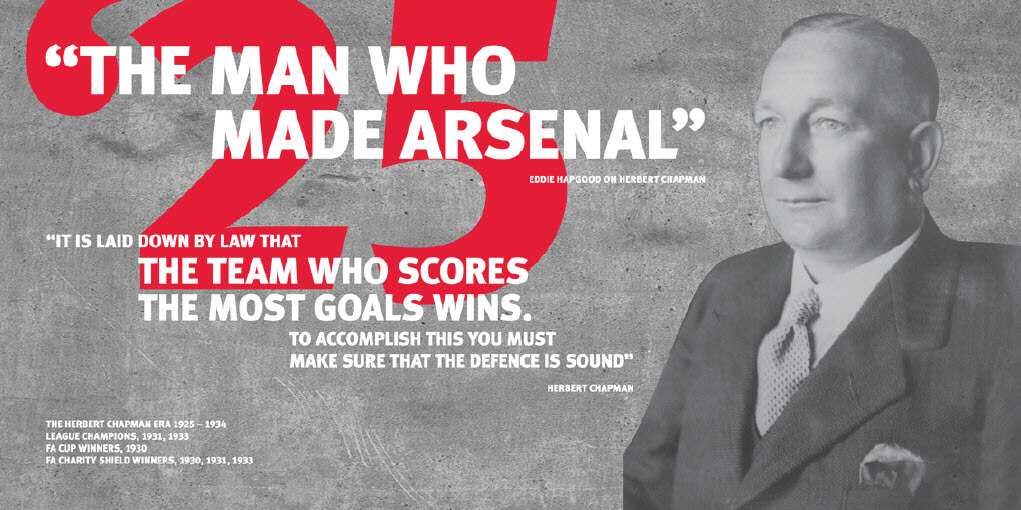Who was Herbert Chapman?
- 902 Views
- aksceditor
- August 13, 2016
- History
In 1925, Arsenal Chairman Sir Henry Norris placed an ad in the Athletic News newspaper. It read
“Arsenal Football Club is open to receive applications for the position of Team Manager. He must be experienced and possess the highest qualifications for the post, both as to ability and personal character. Gentlemen whose sole ability to build up a good side depends on the payment of heavy and exorbitant transfer fees need not apply.”
Little did he know, the position would eventually be filled by none other than Herbert Chapman, who is arguably the greatest Arsenal manager in the club’s history. He contributed innovative ideas and practices both on and off the pitch, changing the face of Arsenal Football Club, and the wider Footballing world in general – forever.
Born in Hendon, Middlesex, Herbert Chapman studied Engineering whilst pursuing his dream Football career as a forward. Over the course of twelve years, Chapman played for a grand total of eleven different clubs, making just one hundred and six appearances. Forty-two of which were for Arsenal rivals, Tottenham Hotspur.
Herbert Chapman didn’t have much success playing Football, but found plenty of it in his managerial career.
Between the years 1907 and 1925, Chapman managed Northampton, Leeds & Huddersfield respectively, Taking time off during the first World War to successfully manage a munitions factory. However, it was Chapman’s four years spell at Huddersfield which saw his rise to real Footballing fame.
Between 1921 and 1925, Chapman transformed Huddersfield from relegation battler to title winners. He was commended and championed for his use of tactics, which varied each game depending on the opposition. A system never of heard before in Football.
Sir Henry Norris, wealthy property developer and chairman of Arsenal in 1925, had spent hundreds of thousands of pounds on The Gunners. Arsenal enjoyed their newly built Highbury Stadium, as well as huge player wages. As mentioned above, Henry Norris was in search of a new manager, and he was offering to pay £2000 a year for the position. Considering the average player wage at the time was £300 per year, it’s easy to see why Herbert Chapman was attracted.
During the previous season, Arsenal narrowly escaped relegation. Chapman’s arrival saw some good transfers being made, but his ingenious footballing reforms didn’t stop there.
At the time, 2-3-5 formation was dominating the Footballing world. Herbert Chapman introduced a ‘Centre-half’ to the backline, re-inventing the popular formation to 3-3-4, otherwise known as the ‘WM’ formation. It was unheard of – but it worked.
Chapman led Arsenal to second place behind his old club Huddersfield in his first season at the club. Due to financial restrictions imposed by Sir Henry Norris, Arsenal’s next few seasons were less successful. But Herbert Chapman had plans.
He perfected ruthless, counter-attacking football over the years, transforming Arsenal into a competitive club. The Gunners won their first piece of silverware under Chapman in the 1930 FA Cup final, beating his old club Huddersfield 2-0. The following season, Arsenal went on to finally win the league, scoring 127 goals in the process – a current club record.
Arsenal set records by winning the League three times in a row between 1933 and 1935. Unfortunately, Herbert Chapman suffered a premature death due to pneumonia half way through the 1934-35 season, Arsenal went on to win the League in his memory.

Throughout his illustrious nine-year Arsenal career, Herbert Chapman didn’t just stop at introducing new formations into the world of Football. Not only did his innovative ideas set trends in the thirties, but they also managed to transcend even today’s practices.
Chapman was the first manager to ever use a tactics board in team meetings and in the dressing room, putting more emphasis on planning tactics than ever before, as opposed to the haphazard style of play that was more commonly practiced at the time.
Additionally, he one day decided to bring his personal gramophone player to a match – thus sparking the trend of playing music in the dressing room.
What’s more is, Herbert Chapman fought against the FA regarding the introduction of shirt numbers for players. He thought numbered shirts would allow players to identify their colleagues more easily, thus improving the flow of the game. The FA initially rejected the idea.
In terms of taking Football forward, Chapman supported the idea of flood-lit football matches to be played at night, as well as ‘goal judges’ to act as what we would today call goal-line technology. Two ground-breaking ideas, the former of which only came into practice in the 1950’s, twenty years after Chapman’s death. The latter is yet to be formally introduced.
These ideas made up a small part of the enormous legacy left behind by Herbert Chapman. He also helped re-design areas of Highbury, including the birth of ‘The Clock End’ stand with it’s famous clock. White sleeved shirts, European tours, feeder clubs and the famous re-naming of Gillespie Road station to Arsenal station all make up the career of arguably the greatest Arsenal manager in history.
One thing is for sure, in light of modern day issues – including financial super-clubs and debates over goal-line technology, today’s Footballing world could use a visionary like Herbert Chapman.



